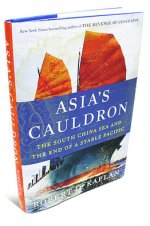PolarBear
Major
- Joined
- Feb 24, 2007
- Messages
- 6,706
John's recent release of a series of China's People Liberation Army with figures representing the navy, air and ground forces would seem to be in tune with what policy experts are saying about that area of the world and its future. This week Robert Kaplan released Asia's Cauldron: The South China Sea and the End of a Stable Pacific. Kaplan recently spoke about the book at the University of Bridgeport. The book emphasizes the importance of maritime geopolitics and China's rapid expansion of its naval forces. John's first release was of female naval cadets. JJD's PLA figures are evidently selling well in China since all are currently listed as "low in stock"
Robert Sammis Lecture Series: Robert D. Kaplan and “Asia’s Cauldron: The South China Sea and the End of a Stable Pacific”
A Review by Steve Hess, Assistant Professor of East Asian and Pacific Rim Studies, University of Bridgeport College of Public and International Affairs
On Wednesday, November 20, UB’s College of Public and International Affairs hosted geopolitical analyst and commentator, Robert Kaplan, as he presented a lecture titled “Asia’s Cauldron: The South China Sea and the End of a Stable Pacific.” In the presentation, Kaplan remarked that we are witnessing a watershed moment in global politics marked by several distinct trends with profound implications for years to come.
First, after two centuries of dominance by Western powers in the wake of the Industrial Revolution, the world is quickly seeing a shift of global economic and military power from the Atlantic to the Pacific Rim. In this context, an American-led international order has come under strain. The guarantor of global security has entered a period of relative decline, with rising powers such as China negotiating their place into a new and redefined global order. How effectively the United States and China navigate this changing geopolitical landscape will be critical to ensuring peace and stability in the coming century.
Secondly, and most provocatively, Kaplan argued that the geopolitics of the 21st century will be heavily influenced – if not determined – by the limits of physical geography. In a period in which scholars have argued that globalization and the diffusion of new technologies have effectively “flattened” the world and enabled the nearly instantaneous free flow of people, commerce and ideas across national boundaries, Kaplan draws inspiration from classic geography-minded strategists such as Halford J. Mackinder and Alfred Thayer Mahan. Kaplan suggests that contestation over the sea lanes of the South China Sea, through which over half of the world’s merchant tonnage and the bulk of East Asia’s oil supplies pass, will emerge as the primary line of conflict in the coming decades.
In this geographic context, international relations in East Asia are overshadowed by a populous and increasingly powerful China. The country’s leadership is concerned with securing stable access to needed energy supplies and commercial sea lanes, maintaining growth to avoid internal instability and territorial fragmentation, and rectifying the historical humiliations endured at the hands of Japan and Western powers in the 19th and early 20th century. These factors have motivated China to rapidly build up its modern blue water navy and assertively stake claims in the South China Sea, in a pattern that according to Kaplan, replicates America’s behavior in the Caribbean in the late 19th and early 20th century.
In response to China’s actions, the nine countries of the South China Sea have increasingly expanded their own military capabilities and sought American support in balancing against a rising China. For Kaplan, the concern among these nine is not Chinese military aggression but rather “Finlandization” – their loss of autonomy in the face of a dominant great power neighbor, akin to Finland’s relations to the Soviet Union during the Cold War. In his view, the strategic negotiation of claims in the South China Sea between China, its neighbors and the United States will in many respects shape the nature of geopolitics in the coming multipolar 21st century.
Robert Sammis Lecture Series: Robert D. Kaplan and “Asia’s Cauldron: The South China Sea and the End of a Stable Pacific”
A Review by Steve Hess, Assistant Professor of East Asian and Pacific Rim Studies, University of Bridgeport College of Public and International Affairs
On Wednesday, November 20, UB’s College of Public and International Affairs hosted geopolitical analyst and commentator, Robert Kaplan, as he presented a lecture titled “Asia’s Cauldron: The South China Sea and the End of a Stable Pacific.” In the presentation, Kaplan remarked that we are witnessing a watershed moment in global politics marked by several distinct trends with profound implications for years to come.
First, after two centuries of dominance by Western powers in the wake of the Industrial Revolution, the world is quickly seeing a shift of global economic and military power from the Atlantic to the Pacific Rim. In this context, an American-led international order has come under strain. The guarantor of global security has entered a period of relative decline, with rising powers such as China negotiating their place into a new and redefined global order. How effectively the United States and China navigate this changing geopolitical landscape will be critical to ensuring peace and stability in the coming century.
Secondly, and most provocatively, Kaplan argued that the geopolitics of the 21st century will be heavily influenced – if not determined – by the limits of physical geography. In a period in which scholars have argued that globalization and the diffusion of new technologies have effectively “flattened” the world and enabled the nearly instantaneous free flow of people, commerce and ideas across national boundaries, Kaplan draws inspiration from classic geography-minded strategists such as Halford J. Mackinder and Alfred Thayer Mahan. Kaplan suggests that contestation over the sea lanes of the South China Sea, through which over half of the world’s merchant tonnage and the bulk of East Asia’s oil supplies pass, will emerge as the primary line of conflict in the coming decades.
In this geographic context, international relations in East Asia are overshadowed by a populous and increasingly powerful China. The country’s leadership is concerned with securing stable access to needed energy supplies and commercial sea lanes, maintaining growth to avoid internal instability and territorial fragmentation, and rectifying the historical humiliations endured at the hands of Japan and Western powers in the 19th and early 20th century. These factors have motivated China to rapidly build up its modern blue water navy and assertively stake claims in the South China Sea, in a pattern that according to Kaplan, replicates America’s behavior in the Caribbean in the late 19th and early 20th century.
In response to China’s actions, the nine countries of the South China Sea have increasingly expanded their own military capabilities and sought American support in balancing against a rising China. For Kaplan, the concern among these nine is not Chinese military aggression but rather “Finlandization” – their loss of autonomy in the face of a dominant great power neighbor, akin to Finland’s relations to the Soviet Union during the Cold War. In his view, the strategic negotiation of claims in the South China Sea between China, its neighbors and the United States will in many respects shape the nature of geopolitics in the coming multipolar 21st century.




